One of the means of protection electrical wiring against short circuits and overloads is a single-pole circuit breaker. It supplies voltage and protects only one wire. Various models circuit breakers differ in ratings and time-current characteristics that determine the shutdown speed.
General structure and principle of operation
The circuit breaker consists of two main mechanisms that ensure its shutdown. These elements are known as releases - electromagnetic and thermal. The action of the electromagnetic release switches off the machine in the event of a short circuit, and the thermal release operates in case of excess permissible load for a long time.
These devices play an important role in electrical distribution systems. With their participation, managing lines departing from , becomes much safer. The operating voltage of the machine is 120 volts. The most widely used circuit breakers are 16 and 25 amperes. These circuits allow you to effectively protect the devices and electrical networks connected to them.
In addition to protection against power surges, circuit breakers control the number of equipment connected to local network. If overload occurs, the current supply is stopped. In the absence of this function, there is a high probability of a wiring fire. Some machines have thermal response mechanisms. They are called single-pole thermomagnetic circuit breakers, installed in networks where there is a high probability of overheating and fire.

In most cases, protection is provided by an automatic modular switch of the BM40 brand. It is capable of carrying current up to 32 amperes, with a maximum number of duty cycles of up to 30.
All machines are designated by letter markings:
- The designation “A” corresponds to devices connecting group loads in apartments or private houses, used mainly in domestic conditions.
- Marking “B” is used in protective devices in networks with heavy loads, where the need for electricity increases significantly.
- Machines marked with the letter “C” are used in industrial buildings, factories and other production facilities.
Installation and connection diagram of single-pole circuit breakers
In modern housing, electrical wiring may consist of several groups protected by a separate circuit breaker. In many cases together. They connect to the lines washing machines, boilers and other high-power equipment.

The connection of protective devices is carried out according to a simple scheme. First of all, the installation site in the panel is prepared. A DIN rail is purchased and installed inside. Then, the machine gun is fixed on it. It should be remembered that it is not recommended to replace one two-pole device with two single-pole devices. This can cause system malfunction and even a wiring fire. The installed machine is secured using special screw clamps.

After installation, the power wire is connected to the top terminal. The bottom terminal is connected to the corresponding protected part of the electrical wiring. Compressing the wires in the terminals should ensure reliable contact, however, the core cannot be pinched too much, otherwise it will quickly break off. In some cases, a single-pole circuit breaker is installed using a special release, which allows you to remove the device with one click on the installation button.
Polarity of circuit breakers
Circuit breakers are designed to disconnect electrical networks in case of excess operating current and short circuits. They protect electrical wiring and consumers connected to it from overloads and contain from one to four poles. Circuit breaker three-pole is designed to protect three single-phase wiring at the same time. If an accident occurs on one of the lines, three poles are switched off at once.
The device solves the following problems:
- protection of a network section;
- preventing breakdown of a section of the circuit;
- at making the right choice prevention of unauthorized shutdowns.
Characteristics
The main characteristics of the machines are the rated breaking capacity and cut-off speed. They are triggered by two shutdown mechanisms: electromagnetic and thermal. The first opens the circuit in the event of a short circuit, and the second - from the action of a continuous load exceeding the rated load. The machine can be used as a switch via the control key.
Rated breaking capacity
The characteristic shows the maximum value permissible current short circuit, in which the switch is capable of de-energizing the wiring with the devices connected to it at least once. It is indicated on the body of the machine and has the meaning:
- 4.5 kA - for short circuit protection power lines private housing, where the line resistance from the substation to the loads does not exceed 0.05 Ohm;
- 6 kA - protect the residential sector and public places, where the line resistance is not lower than 0.04 Ohm;
- 10 kA - used to prevent damage to power lines near the substation.
Time-current characteristics
Uneven power consumption caused by load changes and circuit devices turning on or off can cause nuisance trips of protective devices due to excess current ratings. To reduce the likelihood of their operation, automatic machines with specified time-current characteristics(VTH). The parameter shows the cut-off time at a certain current ratio to the rated value. VTX are as follows.
- B - the electromagnetic release is triggered after 0.015 seconds when the current increases threefold in relation to the nominal value.
- C is the most common characteristic when the protection is triggered when the nominal value increases by 5 times. The machines are suitable for lighting and household appliances with moderate starting currents.
- D - machines are designed for large ones, for example, when turned on electric boiler, electric motors and other three-phase devices. Mainly used in industry.
Overview of circuit breakers
The machine is connected between the current source and the electrical wiring, which should be protected. A three-pole circuit breaker consists of three contact pairs, each of which is connected in series with thermal and electromagnetic releases. The machine only disconnects the phases without breaking the neutral, which is not connected to it. If there is a need to turn off neutral wire, four-pole models are used. They are usually used on main inputs.
In apartments and private houses, class C machines are used for moderate loads. The current strength is selected according to the power of the connected devices, where the threshold value is twice the nominal value in order to eliminate false alarms.
The products of the companies IEK, EKF, DEK, INTES and Kontaktor are widely distributed. Domestic products have sufficient reliability and reasonable prices. Automatic machines with 16 A and 25 A are widely used. Imported ones are more expensive, but well-known companies produce high-quality and reliable models. For a three-pole device, the price of well-known companies may vary greatly, but it is quite consistent with the quality. 
A protective device with three-phase current is used at the entrance to the house and to power professional machines with a voltage of 380 V, for example, a three-pole 100A automatic switch. 
The meter must correspond to this power if it is located after the switch. Usually it is no more than 63 A. A more powerful three-pole circuit breaker is used in industry.
From the reviews and advice of experienced electricians, it follows that machines with inflated ratings should never be used. This poses a risk of fire or equipment failure.
A four-core wire with three phases and a working zero is connected to residential buildings. They rarely use equipment designed for 380 V. The phases are separated. This results in 3 separate lines with a voltage of 220 V.
The advantage of multi-pole machines is the ability to control several lines simultaneously. By installing a three-pole 25A automatic switch on three devices of the appropriate power, you can control each individual line. If a short circuit occurs on one of them, all of them will turn off at once. Typically, additional single-phase switches are installed on each line. If one of them fails, the three-phase one will operate, which increases the reliability of the system. 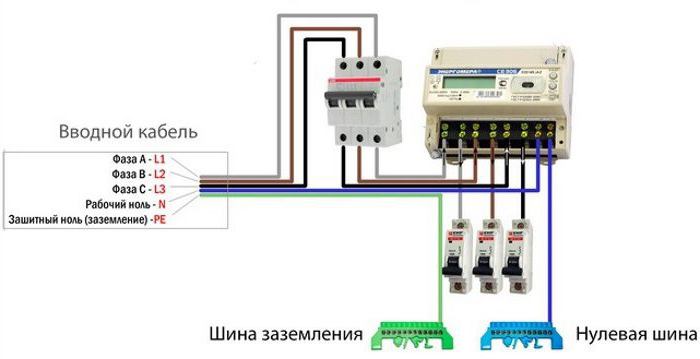
BA series machines
Domestic machines are produced in the AE and BA series. The first type is outdated and rarely used. It has low housing strength and no connection to the DIN rail. For household use BA series products are better suited, designed for currents up to 63 A, characteristics B, C, D and breaking capacity of 4.5 kA.
Domestic three pole switch automatic VA is fully responsive modern requirements, while having a price significantly lower than imported models. 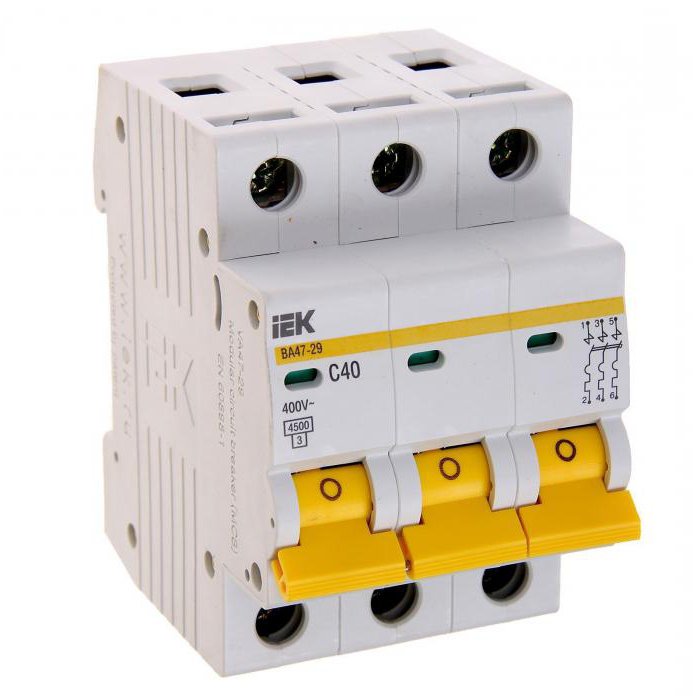
If you believe numerous reviews, imported models with such high prices must be perfect. But they misfire, although less often than domestic models.
Conclusion
The three-pole circuit breaker is important part home electrical system. Choosing expensive models, it should be taken into account that all other equipment must be of the same level: wiring, switches and sockets, distribution boxes, lighting fixtures.
The main characteristics of the machines are always on the front side of the case. They are selected taking into account the cross-section of the wire and the size of the connected load.
Hello, dear readers and guests of the Electrician's Notes website.
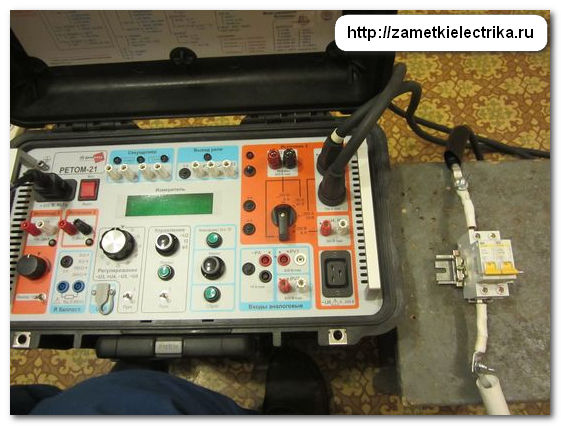
We connect the connecting wires from the RETOM-21 testing device to the terminals of the first pole and turn on our “combined” machine.
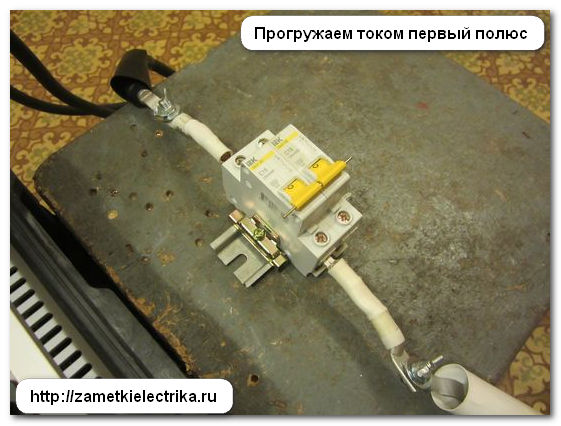

We will load the machine with 4 times the rated current, i.e. current 64 (A). Let me remind you that, according to , the thermal release at this current should operate in a time of approximately 1.7 to 18 (sec.).
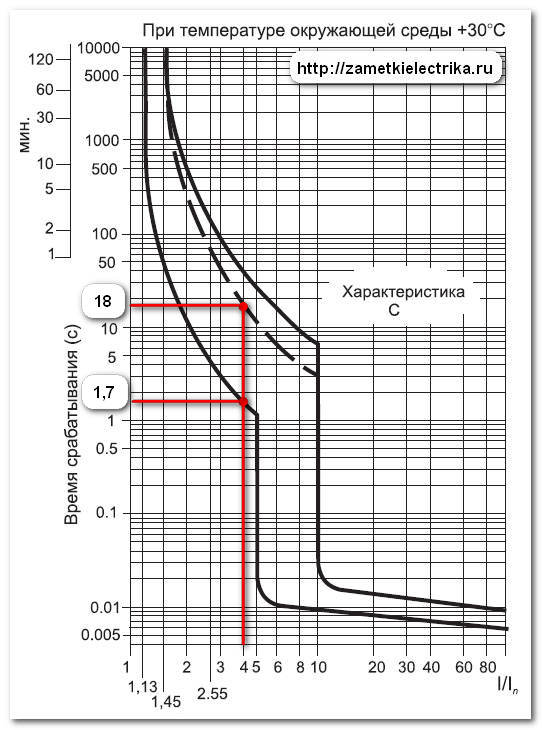
And what do we see?!
There was a click and the loaded pole actually turned off. This can be seen both from the current in the circuit (the current is zero) and from the data from the RETOM-21 stopwatch. By the way, the measured response time of the thermal release was 3.31 (sec.), which corresponds to the time-current characteristic.
![]()
You can also check the condition of the contact of the loaded pole using a multimeter. As you can see, the machine contact is open.
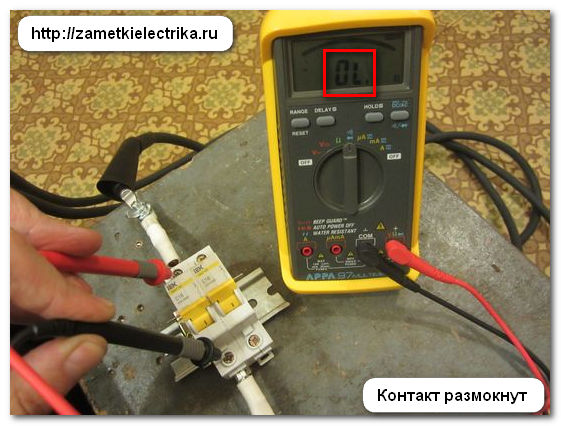
But the most interesting thing is that at the same time its control lever remained on, thereby not turning off the neighboring pole! He simply lacked mechanical strength.
Thus, it turns out that the loaded pole was turned off, but the neighboring one remained closed (on).
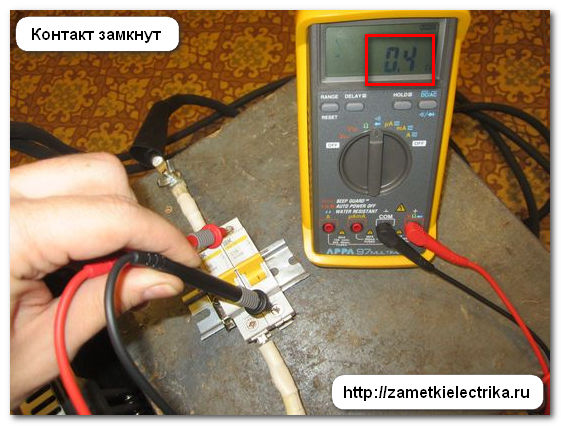
Why is there not enough mechanical strength? How then do factory-made two-pole and three-pole circuit breakers turn off?
It's simple. Remember, I showed that two-pole and three-pole modular circuit breakers have a mechanical connection in the form of pusher forks between their release mechanisms. When one of the releases is triggered, these forks also trigger adjacent poles.

But in our case, when two single-pole circuit breakers are independently combined, there are no pusher forks, so the return spring of one lever simply does not have enough mechanical force to turn off the adjacent lever.
Even if you have similar pusher forks somewhere in stock, you still won’t be able to connect the machines, because the housings of single-pole circuit breakers do not have holes for them (at least IEK and Schneider Electric certainly do not have them).
Experiment No. 2. We connect three single-pole circuit breakers
In principle, even without an experiment everything is already clear how the matter will end, but nevertheless it is necessary to check.
We take three single-pole circuit breakers BA47-29.
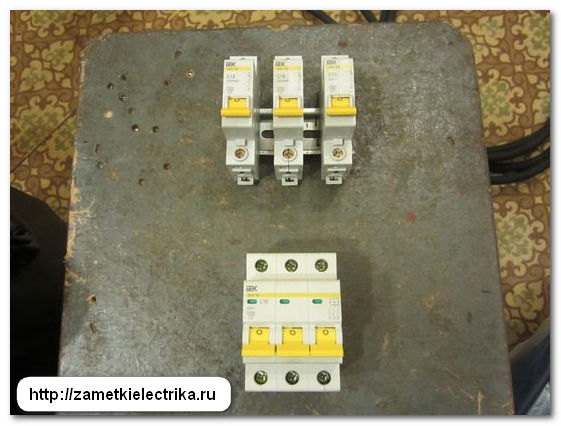
We install the machines on a DIN rail, for reliability we tighten them together with DIN rail stops and combine all three levers.
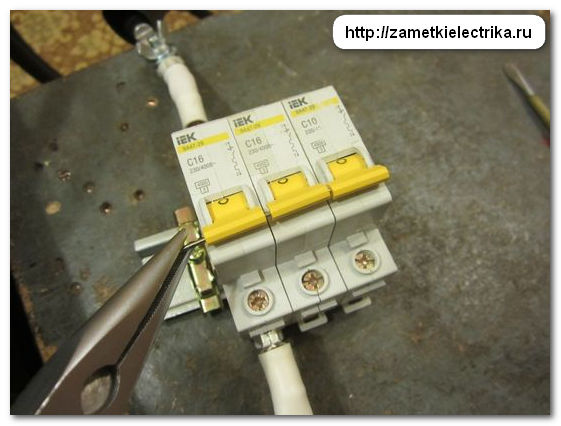
In the same way, we load all the poles one by one. For more information about this, see the video located at the end of the article.
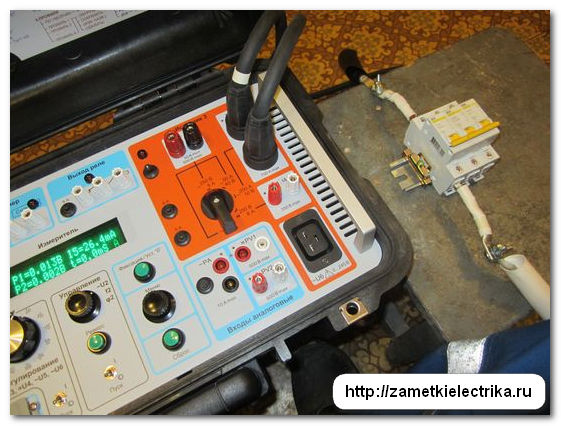
For example, when loading the middle pole, it turned off in 3.14 (sec.).
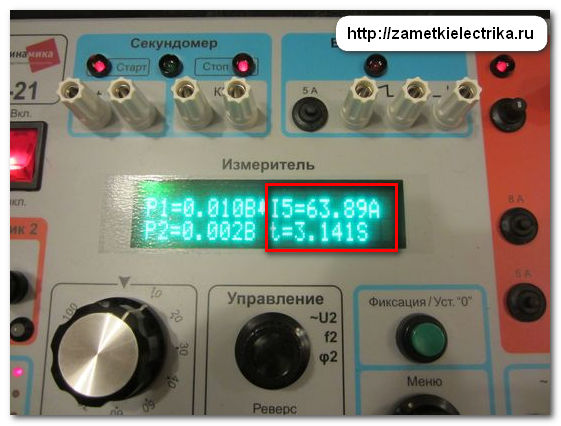
But as you can see, the situation is repeating itself again!
The mechanical forces of his lever were not enough to turn off the neighboring poles. Here is the contact state of the loaded pole.
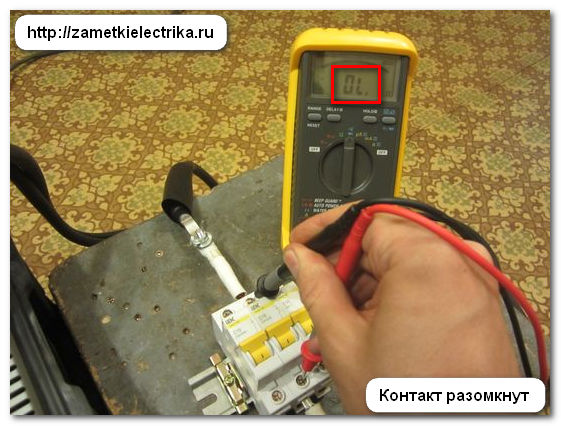
And here is the state of the contacts of neighboring poles.


Let's draw conclusions.
It is prohibited to combine single-pole circuit breakers into two-pole and three-pole circuit breakers. If a short circuit or overload occurs in one of the poles, only this same pole of the machine will turn off, and the neighboring ones will remain closed. And what then is the point in such a connection of machines?
Imagine a simple situation. Your electric motor is connected through such a “combined” circuit breaker directly without protection against phase failure. Let's assume that something happened in the power cable short circuit phases to ground. In this case, the machine installed in this phase will turn off, while the neighboring ones will remain in operation.
What will this lead to? The motor will go into two-phase mode and may eventually fail, depending, of course, on the load on its shaft. To prevent such situations, phase control devices are even specially installed, for example.
This is just one example. In fact, many examples can be given, and with the help of such “unifications” of machines, situations with more serious and sad consequences can arise.
Watch the full version of the experiments in my video:
P.S. Dear electricians, home craftsmen and everyone involved with electricity. Remember that single-pole circuit breakers will never turn into multi-pole circuit breakers, and vice versa. That's all, thanks for your attention.
